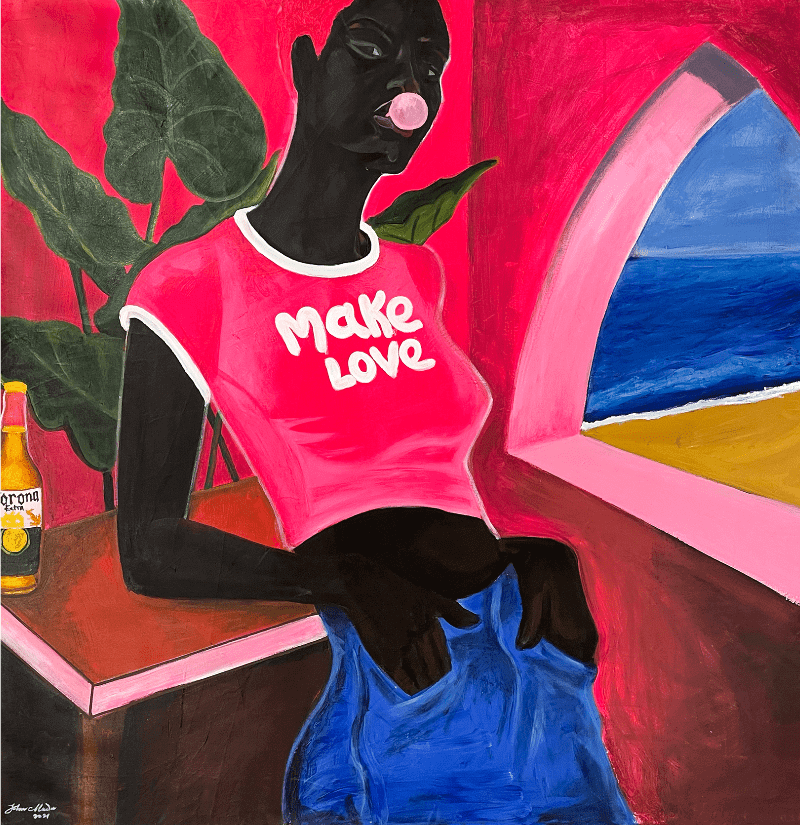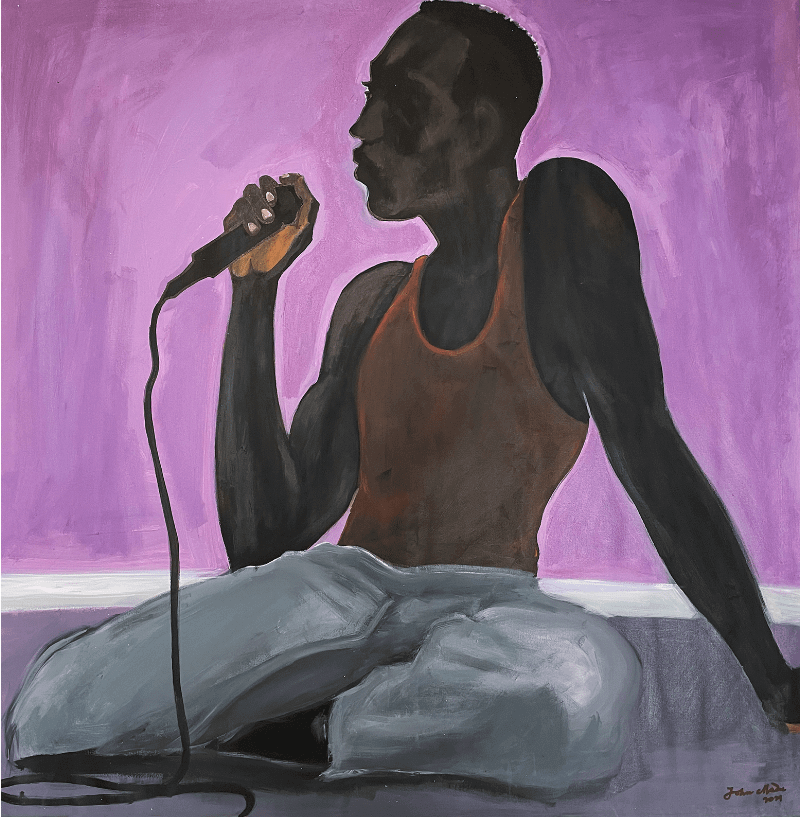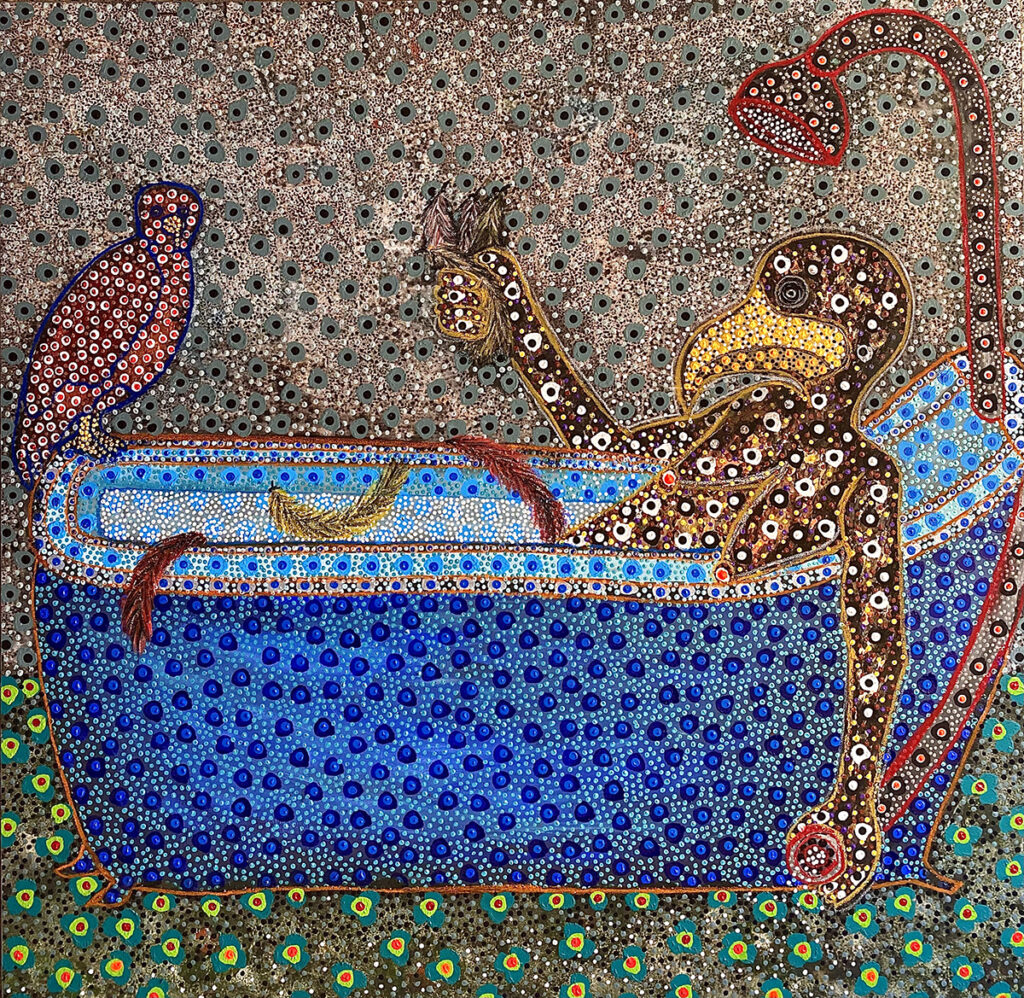In this spotlight series, we interview and showcase artists and their work to our community
AFIKARIS Gallery presents Figures of Power, a joint exhibition of rising Nigerian artist John Madu and Senegalese artist Ousmane Niang. On view from July 10—August 14, 2021, this new exhibition, the first in France for both artists, brings together over 20 all-new works, addressing notions of power and domination as they unfold through gender and political dynamics. Boldly exposing and bridging each artist’s distinct approach to these topics, AFIKARIS once again demonstrates its commitment to propelling the voices of its artists.
Using their art as a weapon, both artists look back and reappropriate histories governed by the duality between dominant and dominated. Turning to gender dynamics, John Madu overturns traditional clichés on identity in the context of globalization, while Ousmane Niang revisits predetermined social hierarchies. Cuttingly pointing to rampant societal issues, they move beyond raw observation, instead coloring their work with a call for action.
John Madu (b. 1983, Lagos, Nigeria) is a multidisciplinary artist living and working in Lagos. With a degree in Policy and Strategic Studies, John Madu is a self-taught artist. Conceived mainly with acrylic, his figurative and symbolic paintings deal with questions of identity, social behaviors, and the effects of cultural globalization on individualism. Highly versatile, Madu’s work is nurtured by endless influences, ranging from popular culture and art to African histories and personal experiences. Symbolism is a distinct marker of his work, as a recurring iconography of books, apples, and other recognizable items come to fill his canvases and convey their own meaning.

Make Love on the beach, 2021
121×121 cm
What’s your creative process like?
My creative process starts with a thought process. I work around the best way to bring up my artworks to reality. The idea in itself is more important than the actual artwork. Because in a way, I try to sort out how I feel the work would appeal more and embody my idea. I usually have a blueprint before I start. Like iconography, dark-skinned subjects, and things that are pretty common in my work.
When did you know you wanted to be an artist?
Being an artist came as an epiphany. However, I have always been attracted to art since my childhood. At that time, I participated in local school competitions and won awards for school projects. I was encouraged to keep practicing my art by my teachers in primary and secondary school. When I was a teenager, the father of one of my friends also supported me. He was the owner of the first private gallery in Ikoyi Hotel, Lagos, in the early ‘90s called ‘Nkem Gallery’. I never believed I would be a professional artist because I didn’t understand how that worked. In 2007, while I was studying at NYSC in Nigeria, I realized that something was happening on the art market in Nigeria. This is when I realized that I could finally be an artist for a living. I sold my first two professional paintings to Nkem Gallery in 2008.
How has your upbringing influenced the art you create?
My art reflects mostly my personal experiences. Growing up in the ‘80s in Lagos has been one influential factor in my artistic path. As well as the part where I grew up in Lagos. I grew up in the suburbs. There was a lot of cultural evidence everywhere in my area. There were galleries, mostly selling artifacts by artisans. There were video clubs, nightclubs, and karaoke. All these things shaped the way I see the world. Lagos is a very cultural city. And I feel that growing up there, just made me infused myself in the culture of the city. It sharpened my creative mind.

A song for Maness, 2021
121x121cm
What alternative career do you think you’d be good at?
I have a BSc in policy and strategic studies so I imagine I could have had a career in this field.
What is your idea of utopia?
My perfect world is a world where you can be whoever you truly are and whoever you want to be. It is a world where there is no restriction regarding your gender.
How has your art evolved over time and what inspires your different techniques?
My artistic process starts from the cognitive. Thus, my art has evolved over time depending on what I was concerned about. The mediums and techniques I use, mostly depend on what I’m trying to achieve in my work. Most of the time, I use acrylic paint. But it is not just limited to acrylic paint. I also use oil, collage, mixed medium in general. So, it depends on what I want to transcribe at that moment. I use a palette knife to create texture. By using this tool, I try to give body to the work.
Ousmane Niang (b. 1989, Tamba, Senegal) works and lives in Dakar. A graduate of the National School of Arts in Dakar, he works primarily with acrylic. Calling to his personal bestiaries, his paintings, deeply influenced by pointillism, depict scenes of daily life. Addressing notions of power, the human-animal figures that populate his canvases convey the endurance and fragility of social beings in the face of domination – as it governs freedom, tyranny, sharing, traditions, technologies, and family life

Jeu de cartes, 2021
Acrylic on Canvas
140x140cm
What’s your creative process like? Do you sketch before you paint?
I feed my inspiration from scenes I see in the street. So, I draw the raw idea in my sketchbook. Then, back in the studio, I realize a sketch on the canvas before adorning it with dots. Sketching is the base of my canvases.
When did you know you wanted to be an artist?
When I was very young, I already liked painting. I even used to paint my shoes. I also painted murals in my bedroom. I love art. So, through time, I entered the world of ideas, and art appeared to be the only route for me. I can’t remember the time when I was not willing to be an artist.
How has your upbringing influenced the art you create?
My upbringing allowed me to have a very personal approach to my art. Through my canvases, I bring forward that each problem has its very own solution. This thought came from all the research I have done.

Baignoire, 2021
Acrylic on Canvas
140x140cm
What alternative career do you think you’d be good at?
I believe that there would not be an alternative career possible for me. In my life, no matters where I look, I only see art.
What is your idea of utopia?
I always try to depict an ideal, flawless, and perfect society; a society without any inequality. The idea of utopia that I represent in my work is an ideal political regime that would govern men perfectly.
What made you choose the human-animal figure to convey your message? And what message are you trying to convey with your art?
Choosing the human-animal figure to convey my message is a way to educate people to invite them to change their behaviours. As an artist, my main role is to provide solutions to the main issues the world currently must face. I want to initiate the youngsters at research and creation to prevent them from being only consumers.


